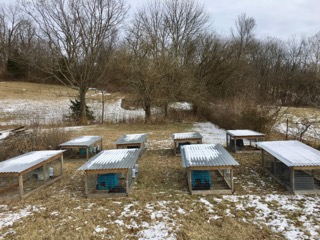 It snowed here a few days ago. It’s fun until the snow lingers, like it has, due to the cold. Walking on it packs it down, and the sporadic sunshine melts it a bit, so it becomes icy…which means it’s really slippery, and no one wants to involuntarily ice skate while holding a basket full of eggs. You might think that the rabbits need to come inside with temperatures below freezing and snow on the ground, but they actually do just fine in cold temperatures, if you take specific measures to ensure their comfort.
It snowed here a few days ago. It’s fun until the snow lingers, like it has, due to the cold. Walking on it packs it down, and the sporadic sunshine melts it a bit, so it becomes icy…which means it’s really slippery, and no one wants to involuntarily ice skate while holding a basket full of eggs. You might think that the rabbits need to come inside with temperatures below freezing and snow on the ground, but they actually do just fine in cold temperatures, if you take specific measures to ensure their comfort.
First, proper protection from the wind and rain is important. When we saw that snow and very cold temperatures were predicted, we “winterized” the rabbits’ houses.
This involves zip-tying the bottoms onto their plastic houses so they can’t separate the pieces, and putting in a nice thick layer of straw to keep them warm. They can get inside to get out of the wind or rain or lounge on top and still stay dry. The tractors have metal roofs with a lip to keep out most of the snow, though some may still blow in from the sides.
Second, their water must be refreshed at least twice a day, and if it’s really cold and the water’s freezing fast, three times a day. We take 5-gallon buckets of warm water out to replace the cold or frozen water in their bottles, and the rabbits eagerly drink it. The real problem with the plastic water bottles is the metal spigot – it will freeze before the water in the bottle does, if the rabbit isn’t constantly keeping water flowing through it (like water pipes in a house). The metal spouts are very easy to thaw, and tossing them into a bucket of hot water will unclog the ice quickly. If we know that the temperatures will dip below freezing at night, we remove the water bottles in the evening and bring them inside so they’re ready to be filled with warm water in the morning. We used to use ceramic crocks, break out the ice, and refill, but the water bottle method works at least as well and is more efficient.
Third, while rabbits will dig down into the snow for forage, it can’t be too deep…so the snow must be removed. A snow shovel is handy for scraping off the layer of snow so that the tractors can be moved onto the new ground, and it’s a good workout, to boot! Keeping them moving keeps them off their own waste – the ammonia in rabbit urine can cause respiratory problems, and no animal should have to live in their own feces. The rabbits were happy to move to new ground this morning and immediately started eating the grass. They have thick fur on their feet, too, so they can handle walking around on the residual snow.
Snow can be managed relatively easily without compromising the well-being of pastured rabbits, but mud is another matter entirely. We’ll talk about the issues mud creates in an upcoming post, since rain is in the forecast. Mud is a real pain in the…well, you know what.
